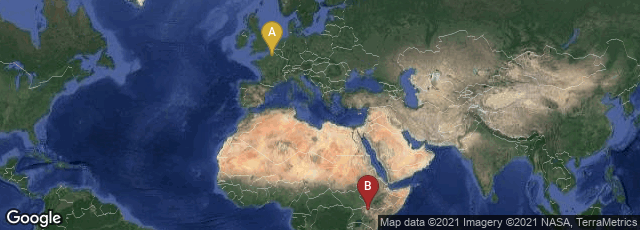
A: Amiens, Hauts-de-France, France, B: Marsabit County, Kenya
During the Lower Paleolithic era prehistoric hominins manufactured stone tools, characterized scientifically as Acheulean (Acheulian), across Africa and much of West Asia and Europe. Acheulean tools are typically found with Homo erectus remains.
"The Mode 2 (eg Acheulean or Biface) toolmakers also used the Mode 1 flake tool method but supplemented it by also using wood or bone implements to pressure flake fragments away from stone cores to create the first true hand-axes. The use of a soft hammer made from wood or bone also resulted in more control over the shape of the finished tool. Unlike the earlier Mode 1 industries, the core was prized over the flakes that came from it. Another advance was that the Mode 2 tools were worked symmetrically and on both sides (hence the name Biface) indicating greater care in the production of the final tool" (Wikipedia article on Stone tool, accessed 04-04-2009).
"Providing calendrical dates and ordered chronological sequences in the study of early stone tool manufacture is difficult and contentious. Radiometric dating, often potassium-argon dating, of deposits containing Acheulean material is able to broadly place the use of Acheulean techniques within the time from around 1.65 million years ago to about 100,000 years ago. The earliest accepted examples of the type, at 1.65 m years old, come from the West Turkana region of Kenya although some have argued for its emergence from as early as 1.8 million years ago.
"In individual regions, this dating can be considerably refined; in Europe for example, Acheulean methods did not reach the continent until around one million years ago and in smaller study areas, the date ranges can be much shorter. Numerical dates can be misleading however, and it is common to associate examples of this early human tool industry with one or more glacial or interglacial periods or with a particular early species of human. The earliest user of Acheulean tools was Homo ergaster who first appeared almost 2 million years ago. Not all researchers use this formal name however and instead prefer to call these users early Homo erectus. Later forms of early humans also used Acheulean techniques . . . .
"It was the dominant technology for the vast majority of human history and more than one million years ago it was Acheulean tool users who left Africa to first successfully colonize Eurasia. Their distinctive oval and pear-shaped handaxes have been found over a wide area and some examples attained a very high level of sophistication suggesting that the roots of human art, economy and social organisation arose as a result of their development. Although it developed in Africa, the industry is named after the type site of Saint Acheul, now a suburb of Amiens in northern France, where some of the first examples were identified in the 19th century" (Wikipedia article on Achulean, accessed 04-04-2009).
♦ "These kinds of Acheulean artifacts, as they are known, have been found in Africa dating back about 1.5 million years. But in Europe, the oldest hand axes that had been found dated to only half a million years ago. Scientists have wondered why it took so long for early humans with such refined toolmaking to show up in Europe.
"Now research from two sites in southeastern Spain provides an answer: it didn’t take that long, after all.
"Using paleomagnetic dating, Gary R. Scott and Luis Gibert of the Berkeley Geochronology Center in California have determined that rather than being about 200,000 years old, the two sites, Solano del Zamborino and Estrecho del Quípar, are about 760,000 and 900,000 years old, respectively."
"Dr. Gibert said the finding, which was published in Nature, adds to mounting evidence that humans migrated to Europe from Africa earlier than previously thought.
" 'The question is, which route did they follow?' he said. Rather than coming through the Middle East and then westward, Dr. Gibert said he is convinced they came across at Gibraltar. 'We think the Gibraltar straits were a permeable barrier,' he said. 'It’s a provocative interpretation, but I think there is enough information to support it' " (http://www.nytimes.com/2009/09/08/science/08obaxe.html?scp=1&sq=stone%20tools&st=cse, accessed 09-12-2009).